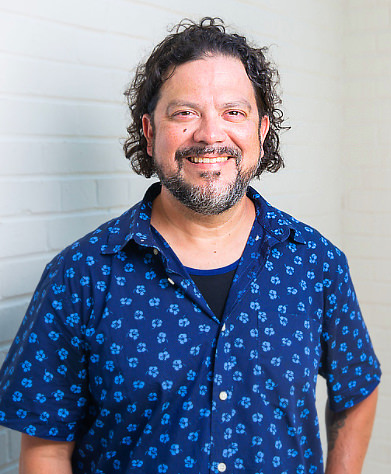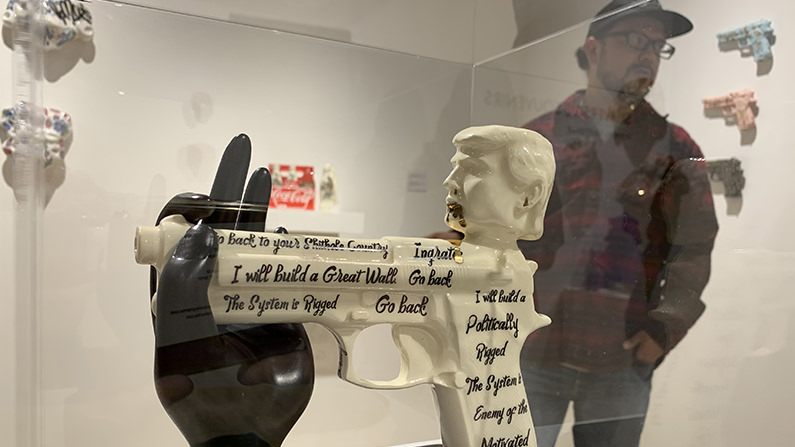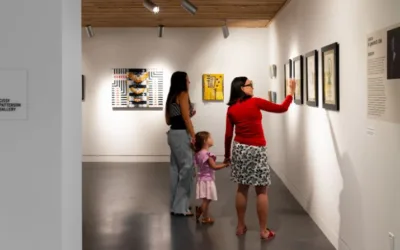The Center for the Arts is hosting a ceramist named Horacio Rodriguez in the days leading up to the opening of his exhibit, “Subversive Souvenirs,” on Wednesday, Oct. 27. Rodriguez was born in Texas to a Puerto Rican mother and Mexican father, and his artwork is heavily influenced by Indigenous cultures of the Americas and current immigration policy.
KHOL contributor Alicia Unger interviewed Rodriguez ahead of his visit to Jackson. The following transcript has been edited for clarity and brevity.
ALICIA UNGER: Hola Señor Rodriguez. Thank you for joining us today on KHOL. Can you tell us about why immigration has become such a big theme of your work?
HORACIO RODRIGUEZ: When I was a kid, when I was 10 years old, I was at my grandmother’s house for the summer and she had a lady that took care of her from Nicaragua. And when I was there that summer, the lady[‘s] daughter crossed [the U.S.-Mexico border] in Arizona, and she was 19 and she died. And I was there, you know, when she found out. And that really affected me. That, with the students that I taught when I returned from Mexico, I got a job at [César E.] Chávez High School in Houston, teaching mainly immigrants, and just hearing their stories and getting to know them better really wanted to make me do something.
UNGER: Those are very powerful and emotional stories, Horacio.

Rodriguez’s exhibit “Subversive Souvenirs” uses pre-Columbian sculptures to comment on modern immigration policy. (Courtesy of Horacio Rodriguez)
RODRIGUEZ: They are. So, this summer, I went down to do some research in Arizona. I had a fellowship in Arizona State University, and I volunteered with a group called Battalion Search and Rescue, and they search for migrants at the border. So, I spent a couple of days volunteering with them, hiking in the desert in the middle of the summer and, you know, looking for remains and looking for migrants and kind of experiencing the hardship, just for a little while, of what it’s like to be in the environment there in the desert. So, all of those things have kind of played a part in the art that I have created that talks about the issues of immigration.
UNGER: During that expedition, did you have a close encounter with death?
RODRIGUEZ: Last week*, they found a 15-year-old kid who had been abandoned and he’d been under a tree for four days. He was about to die, and they got him to the hospital. And, you know, most of the time it doesn’t work that way. Most of the time they just find remains. They don’t find people who are alive. But this past weekend, they did.
UNGER: Oh my gosh.
RODRIGUEZ: So, I have committed to going to Arizona twice a year to search with that group.
UNGER: Horacio, your recent pieces of art have messages reflecting the experiences you said you had with the undocumented immigrants. What do you think about the past [presidential] administration? What do you think about Donald Trump?
RODRIGUEZ: [Laughs] So, Donald Trump has given me some of my best material to use. I am glad that he’s no longer president, but one of the pieces that’s actually in the show right now was called “Prototypes for a Border Wall Mitigation Device.” And that piece came about when Trump first came into office, he was looking to get different designs and prototypes for the border wall. And I kind of made a protest piece against that, and that was kind of the start of making pieces reacting towards Trump and his presidency and all of the hate speech that he talked about Mexico. One of the pieces that’s going to be in the show in Jackson is called “Brown Boys for 45,” and it’s a series of five sculptures and each one of them, they’re wearing the Trump hat, the “Make America Great Again” hat.
UNGER: [Was there] any frustration that you experienced during this time?
RODRIGUEZ: One of the things that really, like, kind of frustrated and confused me is my students—some of my students from Chávez High School back in Houston—were Trump supporters. And it just was hard for me to understand that these students who were, you know, their parents were immigrants. They were recent arrivals. They’d maybe been in the United States for one or two generations, [and it was hard to understand] how quickly they turn around and want to close the door on immigrants who are coming now.
UNGER: Going back to your exposition, how were you able to recreate these pre-Hispanic pieces of art?
RODRIGUEZ: A lot of the pieces, including the “Brown Boys for 45” piece, they all started as pre-Columbian sculptures from the Utah Museum of Fine Arts’ permanent collection. So, they gave me access to seven or eight pre-Columbian pieces. Some of them were from western Mexico. Some of them were from the Yucatán. Some of them were from Veracruz. I used a 3D scanner and was able to scan these objects. One of them is going to be a child figure that’s in a cage. Some of them are 1,200, 1,500 years old from pre-Columbian Mexico. And I use those sculptures as a canvas to tell stories about what’s happening now.
UNGER: Horacio, what is your main motivation for this exposition?
RODRIGUEZ: I want to help people. So, that’s really what’s behind my art right now and what’s behind my visit is to educate and to help people.
UNGER: Educate and inspire the new generations through this exposition that will begin on October 27** here in the Center for the Arts of Jackson. Alicia Unger, KHOL.
*This interview was recorded in early October.
**Rodriguez will join the Center for an artist reception and talk starting at 5:30 p.m. on Wednesday, Oct. 27.






